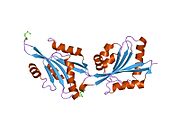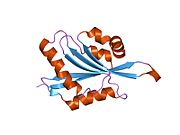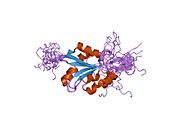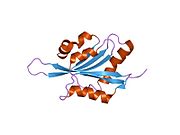Protein-coding gene in humans
| COTL1 |
|---|
 |
| Available structures |
|---|
| PDB | Ortholog search: PDBe RCSB |
|---|
| List of PDB id codes |
|---|
1T2L, 1T3X, 1T3Y, 1TMW, 1VFQ, 1WNJ |
|
|
| Identifiers |
|---|
| Aliases | COTL1, CLP, coactosin like F-actin binding protein 1 |
|---|
| External IDs | OMIM: 606748; MGI: 1919292; HomoloGene: 10898; GeneCards: COTL1; OMA:COTL1 - orthologs |
|---|
| Gene location (Human) |
|---|
 | | Chr. | Chromosome 16 (human)[1] |
|---|
| | Band | 16q24.1 | Start | 84,565,596 bp[1] |
|---|
| End | 84,618,078 bp[1] |
|---|
|
| Gene location (Mouse) |
|---|
 | | Chr. | Chromosome 8 (mouse)[2] |
|---|
| | Band | 8|8 E1 | Start | 120,535,961 bp[2] |
|---|
| End | 120,567,283 bp[2] |
|---|
|
| RNA expression pattern |
|---|
| Bgee | | Human | Mouse (ortholog) |
|---|
| Top expressed in | - monocyte
- granulocyte
- blood
- spleen
- appendix
- lymph node
- retinal pigment epithelium
- ganglionic eminence
- bone marrow
- gallbladder
|
| | Top expressed in | - granulocyte
- mesenteric lymph nodes
- epithelium of stomach
- migratory enteric neural crest cell
- epithelium of lens
- motor neuron
- yolk sac
- mucous cell of stomach
- fossa
- conjunctival fornix
|
| | More reference expression data |
|
|---|
| BioGPS | 
 | | More reference expression data |
|
|---|
|
| Gene ontology |
|---|
| Molecular function | - enzyme binding
- protein binding
- actin binding
| | Cellular component | - cytoplasm
- extracellular exosome
- cytoskeleton
- intracellular anatomical structure
- nucleus
- extracellular region
- secretory granule lumen
- ficolin-1-rich granule lumen
| | Biological process | - defense response to fungus
- neutrophil degranulation
- biological process
| | Sources:Amigo / QuickGO |
|
|
| Wikidata |
| View/Edit Human | View/Edit Mouse |
|
Coactosin-like protein (COTL1 or CLP) is a protein that in humans is encoded by the COTL1 gene.[5][6][7][8]
Function
This gene encodes one of the numerous actin-binding proteins which regulate the actin cytoskeleton. This protein binds F-actin, and also interacts with and thereby stabilizes 5-lipoxygenase (ALOX5). Although this gene has been reported to map to chromosome 17 in the Smith-Magenis syndrome region, the best alignments for this gene are to chromosome 16. The Smith-Magenis syndrome region is the site of two related pseudogenes.[8]
Interactions
COTL1 has been shown to interact with ALOX5.[9] ALOX5 is the first committed enzyme in the metabolism of arachidonic acid to an array of biologically important cell signaling agents: a) the pro-inflammatory mediator, leukotriene B4 (LTB4); b) the airways constrictors, LTC4, LTD4, and LTE4; c) the 5-hydroxyeicosatetraenoic acid family of pro-inflammatory and pro-allergic reactions mediators, 5-HETE and 5-oxo-eicosatetraenoic acid. ALOX5 also contributes to the metabolism of arachidonic acid and other polyunsaturated fatty acids to agents which act block inflammation and allergic reactions, the specialized pro-resolving mediators of the lipoxin and resolvin subclasses. Based on in vitro studies, COTL1 serves to stabilize ALOX5, acting as a chaperone or scaffold, to avert the enzyme's inactivation and thereby to promote its metabolic activity.[10]
References
- ^ a b c GRCh38: Ensembl release 89: ENSG00000103187 – Ensembl, May 2017
- ^ a b c GRCm38: Ensembl release 89: ENSMUSG00000031827 – Ensembl, May 2017
- ^ "Human PubMed Reference:". National Center for Biotechnology Information, U.S. National Library of Medicine.
- ^ "Mouse PubMed Reference:". National Center for Biotechnology Information, U.S. National Library of Medicine.
- ^ Provost P, Samuelsson B, Rådmark O (Apr 1999). "Interaction of 5-lipoxygenase with cellular proteins". Proc. Natl. Acad. Sci. U.S.A. 96 (5): 1881–5. Bibcode:1999PNAS...96.1881P. doi:10.1073/pnas.96.5.1881. PMC 26705. PMID 10051563.
- ^ Chen KS, Manian P, Koeuth T, Potocki L, Zhao Q, Chinault AC, Lee CC, Lupski JR (Nov 1997). "Homologous recombination of a flanking repeat gene cluster is a mechanism for a common contiguous gene deletion syndrome". Nat. Genet. 17 (2): 154–63. doi:10.1038/ng1097-154. PMID 9326934. S2CID 27742511.
- ^ Rakonjac M, Fischer L, Provost P, Werz O, Steinhilber D, Samuelsson B, Rådmark O (Sep 2006). "Coactosin-like protein supports 5-lipoxygenase enzyme activity and up-regulates leukotriene A4 production". Proc. Natl. Acad. Sci. U.S.A. 103 (35): 13150–5. Bibcode:2006PNAS..10313150R. doi:10.1073/pnas.0605150103. PMC 1559768. PMID 16924104.
- ^ a b "Entrez Gene: COTL1 coactosin-like 1 (Dictyostelium)".
- ^ Provost P, Doucet J, Hammarberg T, Gerisch G, Samuelsson B, Radmark O (May 2001). "5-Lipoxygenase interacts with coactosin-like protein". J. Biol. Chem. 276 (19): 16520–7. doi:10.1074/jbc.M011205200. PMID 11297527.
- ^ Anwar Y, Sabir JS, Qureshi MI, Saini KS (2014). "5-lipoxygenase: a promising drug target against inflammatory diseases-biochemical and pharmacological regulation". Current Drug Targets. 15 (4): 410–22. doi:10.2174/1389450114666131209110745. PMID 24313690.
External links
Further reading
- Wu C, Friedlander P, Lamoureux C, Zannis-Hadjopoulos M, Price GB (1993). "cDNA clones contain autonomous replication activity". Biochim. Biophys. Acta. 1174 (3): 241–57. doi:10.1016/0167-4781(93)90193-h. PMID 7690594.
- Provost P, Doucet J, Hammarberg T, Gerisch G, Samuelsson B, Radmark O (2001). "5-Lipoxygenase interacts with coactosin-like protein". J. Biol. Chem. 276 (19): 16520–7. doi:10.1074/jbc.M011205200. PMID 11297527.
- Provost P, Doucet J, Stock A, Gerisch G, Samuelsson B, Rådmark O (2001). "Coactosin-like protein, a human F-actin-binding protein: critical role of lysine-75". Biochem. J. 359 (Pt 2): 255–63. doi:10.1042/0264-6021:3590255. PMC 1222143. PMID 11583571.
- Nakatsura T, Senju S, Ito M, Nishimura Y, Itoh K (2002). "Cellular and humoral immune responses to a human pancreatic cancer antigen, coactosin-like protein, originally defined by the SEREX method". Eur. J. Immunol. 32 (3): 826–36. doi:10.1002/1521-4141(200203)32:3<826::AID-IMMU826>3.0.CO;2-Y. PMID 11870627. S2CID 21684580.
- Gevaert K, Goethals M, Martens L, Van Damme J, Staes A, Thomas GR, Vandekerckhove J (2003). "Exploring proteomes and analyzing protein processing by mass spectrometric identification of sorted N-terminal peptides". Nat. Biotechnol. 21 (5): 566–9. doi:10.1038/nbt810. PMID 12665801. S2CID 23783563.
- Dai H, Wu J, Xu Y, Yajun T, Husheng D, Shi Y (2004). "1H, 13C and 15N resonance assignments and the secondary structures of human coactosin like protein (hCLP) D123N". J. Biomol. NMR. 29 (3): 455–6. doi:10.1023/B:JNMR.0000032550.18424.aa. PMID 15213466. S2CID 27858479.
- Liu L, Wang Y, Zhang P, Cheng Z, Wan M, Zhou Z, Gong W (2004). "Expression, purification and preliminary crystallographic studies of human coactosin-like protein". Acta Crystallogr. D. 60 (Pt 9): 1651–3. Bibcode:2004AcCrD..60.1651L. doi:10.1107/S0907444904016701. PMID 15333945.
- Li X, Liu X, Lou Z, Duan X, Wu H, Liu Y, Rao Z (2004). "Crystal structure of human coactosin-like protein at 1.9 A resolution". Protein Sci. 13 (11): 2845–51. doi:10.1110/ps.04937304. PMC 2286586. PMID 15459340.
- Li X, Liu X, Zhao Q, Liu Y, Duan X, Rao Z (2004). "Crystallization and preliminary crystallographic studies of human coactosin-like protein (CLP)". Acta Crystallogr. D. 60 (Pt 12 Pt 2): 2387–8. Bibcode:2004AcCrD..60.2387L. doi:10.1107/S0907444904028112. PMID 15583396.
- Gevaert K, Staes A, Van Damme J, De Groot S, Hugelier K, Demol H, Martens L, Goethals M, Vandekerckhove J (2005). "Global phosphoproteome analysis on human HepG2 hepatocytes using reversed-phase diagonal LC". Proteomics. 5 (14): 3589–99. doi:10.1002/pmic.200401217. PMID 16097034. S2CID 895879.
- Dai H, Huang W, Xu J, Yao B, Xiong S, Ding H, Tang Y, Liu H, Wu J, Shi Y (2006). "Binding model of human coactosin-like protein with filament actin revealed by mutagenesis". Biochim. Biophys. Acta. 1764 (11): 1688–700. doi:10.1016/j.bbapap.2006.06.017. PMID 17070122.
PDB gallery
-
1t2l: Three Crystal Structures of Human Coactosin-like Protein -
1t3x: Three Crystal Structures of Human Coactosin-like Protein -
1t3y: Three Crystal Structures of Human Coactosin-like Protein -
1tmw: Solution structure of Human Coactosin Like Protein D123N -
1udm: Solution structure of Coactosin-like protein (Cofilin family) from Mus Musculus -
1vfq: The Crystal Structure of Human Coactosin-like Protein at 1.9 A Resolution -
1wm4: Solution structure of mouse coactosin, an actin filament binding protein -
1wnj: NMR structure of human coactosin-like protein |
 | This article on a gene on human chromosome 16 is a stub. You can help Wikipedia by expanding it. |

 1t2l: Three Crystal Structures of Human Coactosin-like Protein
1t2l: Three Crystal Structures of Human Coactosin-like Protein 1t3x: Three Crystal Structures of Human Coactosin-like Protein
1t3x: Three Crystal Structures of Human Coactosin-like Protein 1t3y: Three Crystal Structures of Human Coactosin-like Protein
1t3y: Three Crystal Structures of Human Coactosin-like Protein 1tmw: Solution structure of Human Coactosin Like Protein D123N
1tmw: Solution structure of Human Coactosin Like Protein D123N 1udm: Solution structure of Coactosin-like protein (Cofilin family) from Mus Musculus
1udm: Solution structure of Coactosin-like protein (Cofilin family) from Mus Musculus 1vfq: The Crystal Structure of Human Coactosin-like Protein at 1.9 A Resolution
1vfq: The Crystal Structure of Human Coactosin-like Protein at 1.9 A Resolution 1wm4: Solution structure of mouse coactosin, an actin filament binding protein
1wm4: Solution structure of mouse coactosin, an actin filament binding protein 1wnj: NMR structure of human coactosin-like protein
1wnj: NMR structure of human coactosin-like protein




























